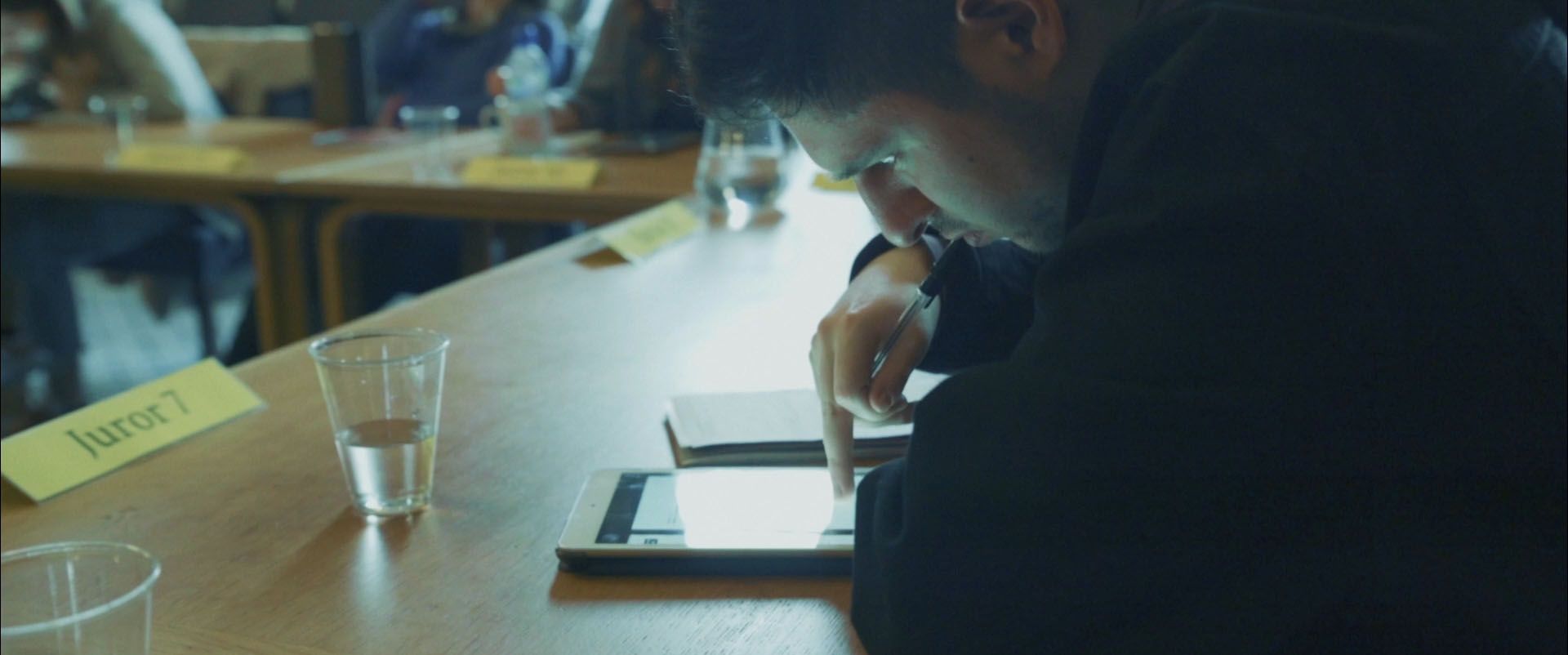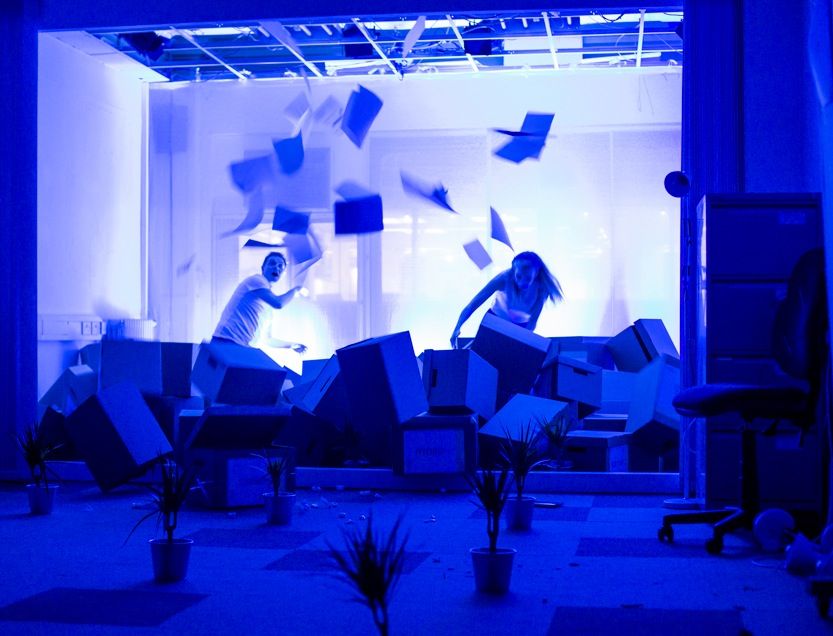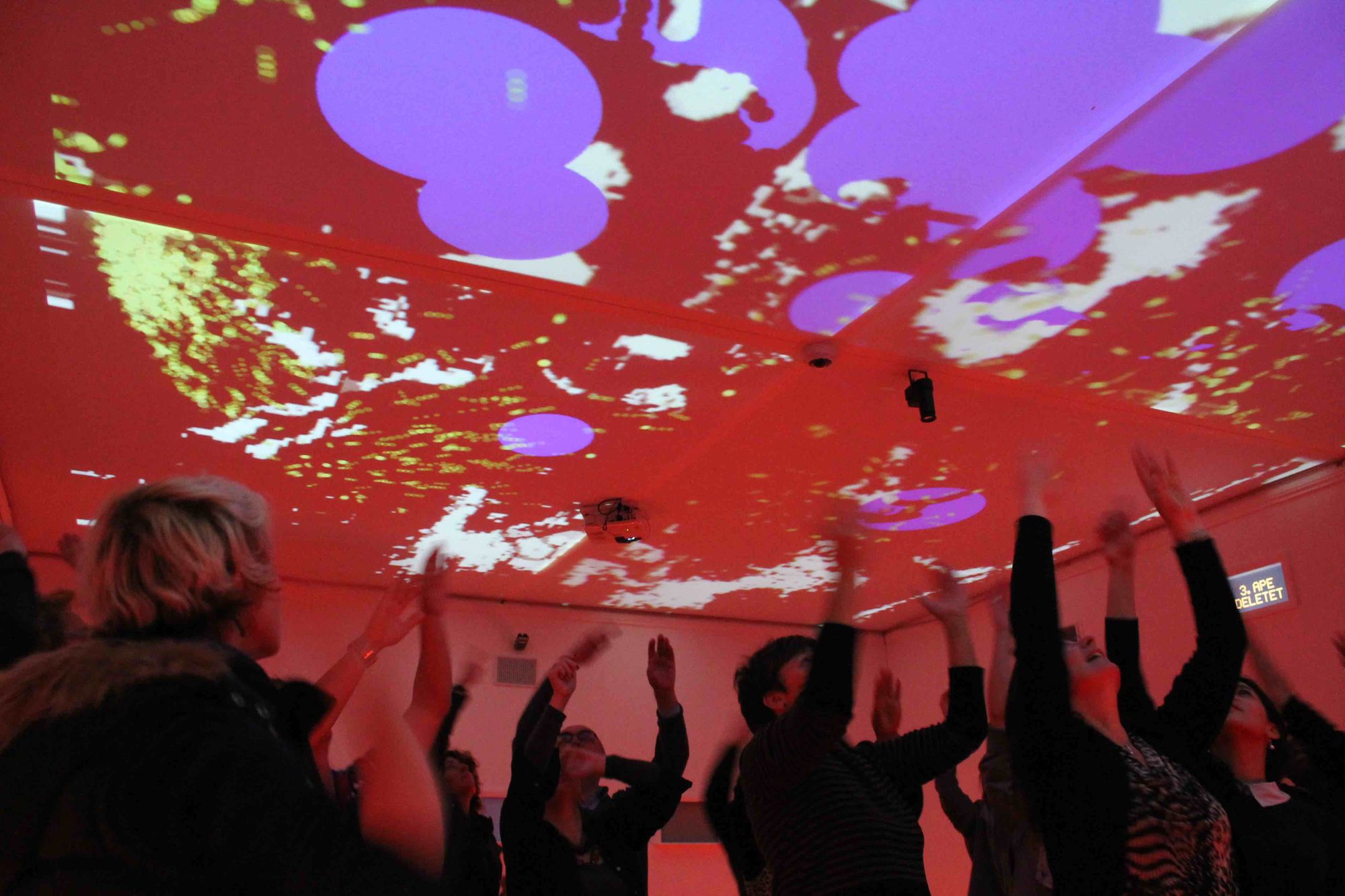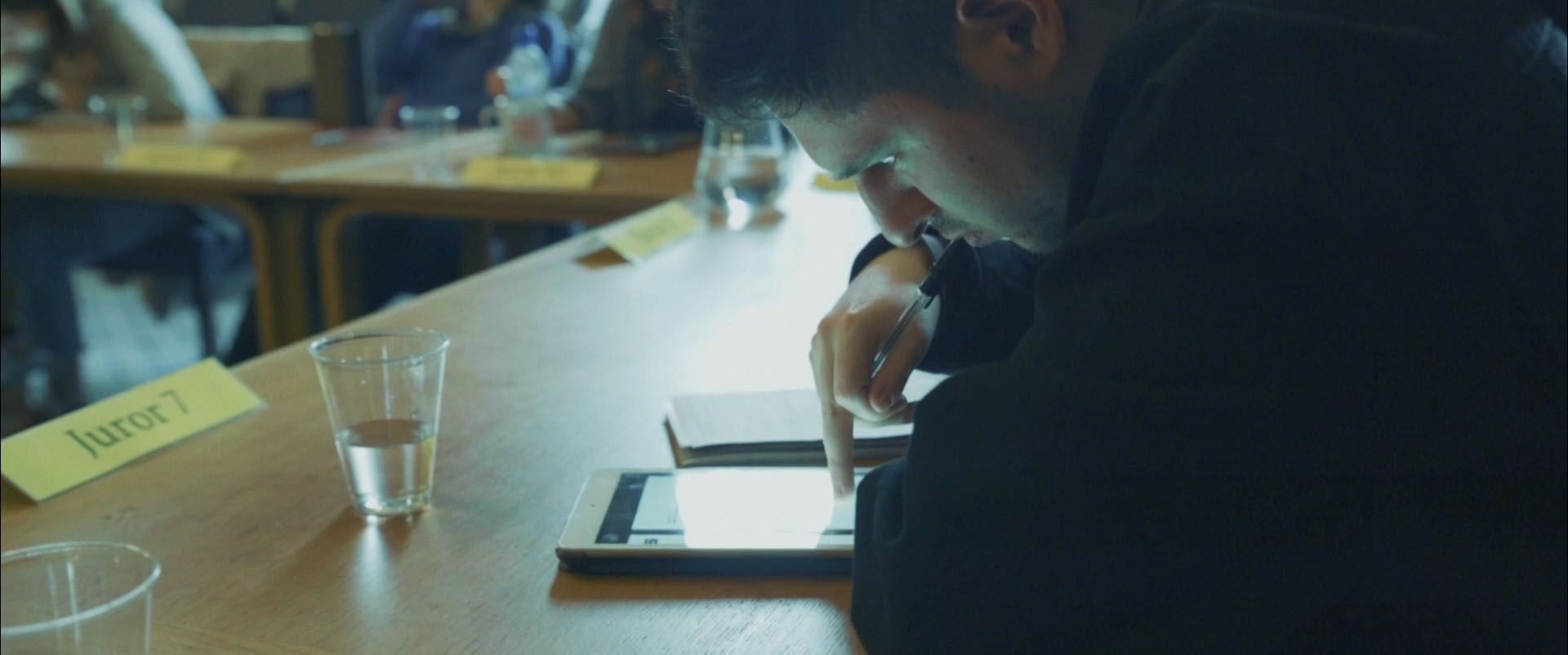It's a kind of magic: multimedia theatre and digital performance
The how and why of multimedia theatre - and a few tips on what we’ve learned while making digital performance (face-to-face and online).

When I talk about Fast Familiar’s work, I describe it as audience-centric theatre - or multimedia theatre, because we use digital technology to help people connect in different ways. Unlike a lot of companies working in the immersive theatre field, we use tech in pretty much everything we make. We think it’s great obviously, or we wouldn’t do it. So here’s the how and why of digital theatre (face-to-face and online) - and a few tips on what we’ve learned about working with multimedia in theatre, in the hopes that it might be useful to you in your own adventures in creating digital performance…
Don't feel like reading?
You can listen to Rachel reading the full post here...
From regular theatre to multimedia theatre
Fast Familiar started out -albeit under another name- in 2007. Back then we were a regular theatre company. We put on plays, with actors, and an audience who sat in the dark and who we pretended weren’t there. By the early 2010s we’d got bored of the theatres who would let us on their stages. We did a lot of work in random buildings, taking advantage of the empty properties that emerged as a side effect of the 2008 financial crash. When we made Cheese in 2013, it was kind of a play, but we were also in the building on Oxford Street opposite Primark and -although we didn’t call it an immersive experience- we created a whole world that began as soon as audiences entered through the nondescript door by the (now gone) Chinese takeaway. Audiences were spectators but they existed within the story-world. The whole experience was powered from batteries that were charged up by people working out in local gyms, so there were already some wild leaps in technology, but that’s another story.

Like much of what we were making, Cheese was a project asking big questions about climate justice. During the first half of the 2010s, we started feeling like there was an increasing tension between the subject matter of our work, which had an activist dynamic and tried to empower people to make change in their lives - and the form that work took: making people sit still and do nothing for however long the show lasted. We knew we wanted audiences to be more ‘active’ within the artworks we made.
No time to finish reading this now, or want it as a document to keep?
Pop your email in below and it's yours!
In 2015, we made a project called Invisible Treasure, in which we wanted to explore complicity with, and agency within invisible systems (like the internet, the financial markets, the national grid). We figured that the subject matter or theme of the project meant that the form couldn’t involve actors in the way our previous projects had done - if we wanted to set up invisible systems, we couldn’t have actors running around. So we started to use technology to create a space that would respond to what the audience said and did. The systems running the show would be invisible and the audience would have to decide how they wanted this temporary society to run. We started making multimedia theatre because it was the right form for the ideas we wanted to explore.
Watching the 30+ groups of audience members play Invisible Treasure was fascinating. In some ways, I think we’re still working through all the ideas that that experience sparked. What we observed was groups of strangers take decisions together, respond in different ways to shifting power dynamics, and collectively decide what was and wasn’t acceptable in their temporary society. The huge thing we took away from the experience was how technology could be like a magic cloak of invisibility: it could allow us to be present as creators, but not in a way that would detract from the relationships that audiences would build with each other. Using technology, we could craft transformative experiences for groups. Our adventures with theatre and technology had begun...

Why keep using multimedia in theatre?
Let’s get something straight. We have nothing against actors. Actors are great. Some of our best friends are actors. In fact, actors are so great that sometimes it’s too much to have them in a show.
We -as I expect you have- had experiences of being in the audience for several interactive performances where the invitation to participate came from a human performer. We noticed that as audience members in these situations we felt a tendency to want to please the performer or to “get it right.” Even in shows where we didn’t really want to do the thing that we were being asked to do, we found ourselves going along with it because - well, because it would be awful if we didn’t.
I remember being in a truly dreadful ‘immersive’ show at the Edinburgh festival where we were nominally concentration camp inhabitants… this show was problematic in basically every way, and I think I was there because the boyfriend of a friend was in it and I wanted to support him. My strongest memory of the show was being yelled at to do various things by the ‘guards’ (one of whom was played by the aforementioned boyfriend); our compliance was then presented back to us as an indicator of our propensity for inhumane behaviour. Throughout the show, I wanted to refuse but I didn’t because firstly, I felt sorry for the actors. What would they have done? They couldn’t have followed through on their threats of violence or shot us with the replica guns they were waving around. The entire concept of the show would have been undermined. Secondly, theatre is a small world and I knew other people in the audience - if I’d behaved ‘badly’ within the show, that could have had both personal and professional implications for me. In short, I was acutely aware of the risk of embarrassment – both for myself or for the performers.
This fear of embarrassment is something that the theatre scholar Gareth White has written about extensively. He writes that “when participatory performance invites performances from audience members, it presents special opportunities for embarrassment.” Indeed it does. He also draws on the Canadian sociologist Erving Goffman’s observation that people engage in ‘defensive practices’ to save ourselves from embarrassment but we also use ‘protective practices’ or ‘tact’ to protect other people from being embarrassed. This was exactly what I was doing in the terrible concentration camp show. And although it’s a particularly gruesome example, I’ve experienced a similar feeling in pretty much every immersive theatre show that uses actors. Maybe I just have an over-active embarrassment-ometer but I often find that that can’t immerse myself in the show because I’m too worried about doing right by the performers.
When we came to make The Justice Syndicate, we thought a lot about how we could minimise embarrassment. Drawing on our experiences with Invisible Treasure, we wondered whether we could avoid people feeling embarrassed if the invitation to participate came from a machine instead of a human. For a start, you can’t be worried that a machine will be embarrassed if you mess up because machines aren’t sentient. How would you offend or embarrass an iPad?
The Justice Syndicate: a case study in multimedia theatre
In The Justice Syndicate, twelve audience members take the role of a jury. Each participant has an iPad that they use to look at evidence. They are prompted to discuss the case with their fellow jurors and to vote whether the defendant is guilty or not guilty. There are no actors, and just one Fast Familiar company member in the corner, pressing ‘go’ on a laptop to advance the experience to the next stage: we don’t speak or intervene. Over 90 mins that temporary society of twelve participants has to find a way of making a decision.
There are no observers because we want everyone in the room to have the same amount of skin in the game. We’ve been asked by various venues to do the show with an audience - so twelve participants as jurors, making their decision while being watched by a larger audience. This would make The Justice Syndicate a much more financially profitable show but would undermine the set-up. We think it’s important that everyone in the room has the same ‘in-game’ status - they are a juror with one vote. In the same way as using actors, having people of different statuses within the game introduces hierarchy and therefore a higher chance of embarrassment. We didn’t want participants with half an eye on the game and half an eye on their audience, wondering ‘what are they thinking?’ That isn’t immersion.
Using machines to reduce/ prevent embarrassment and increase immersion plays out in another way in The Justice Syndicate. In contrast to a real jury, where jurors publicly declare their opinion about the guilt or innocence of the defendant, The Justice Syndicate invites participants to anonymously vote via their iPads. This mechanism allows participants to know how the group is leaning, without experiencing public embarrassment if their vote isn’t in line with that. In some digital performances, this anonymity creates a fascinating dynamic where the conversation is dominated by one set of arguments (e.g. that the defendant is not guilty) but the votes repeatedly show something different (e.g. that the defendant is guilty). Sometimes, participants notice this disparity and it takes the conversation to the next level.
Of course, not everyone is the same, and some people will find being asked to use a tablet device an obstacle to becoming immersed in the show, perhaps because they’re not someone who gets on with this type of technology. Over the 70 shows we’ve done, The Justice Syndicate operating system and UI (user interface - how the user interacts with the device) has gone through 4 iterations - we’re constantly taking what we learn from watching audiences and using it to make the system more intuitive. For us technology is never an end in itself - we’re not in favour of always using technology, we’re in favour of using tech where it allows participants to interact in new or different ways. Perhaps one of our favourite pieces of feedback was from a woman who told us she forgot that she had an iPad (the device on which every stage of the show is accessed) because she’d been so engrossed in the discussions that the material had provoked.
Aside from supporting audiences to increase their sense of immersion, the use of multimedia in our theatre work allows us to use our artworks as research projects (or consensual social experiments). All of the platforms that we’ve built collect anonymised data on the decisions that participants take. Sometimes this data is used by our partners or ourselves for research. It also means that participants can compare their experiences to those of past audiences. We’ve found that people always want to know how typical (or perhaps how special!) they are - and our use of theatre and technology means we can tell them this in pretty granular detail.

Some things we’ve learned on our adventures with multimedia in theatre
1. Invest in your interdisciplinary collaboration
So many collaborations in the arts and tech space are forged over an application form, which is one of the worst ways to start working with someone. Sadly, there aren’t loads of opportunities for people who specialise in technology to encounter people who don’t and vice versa, in non-pressured situations. There’s also a disparity of economies - with people who work in the arts resigned to being paid woefully badly and people who work with technology expecting to paid enough to live - so budgets can be tricky. There’s also questions of shared language and learning how to support each other. We made Invisible Treasure as a shotgun wedding with a studio who no longer exist and it was not an easy experience. We realised that we were often using the same word with completely different meanings. We were asking for things without understanding the technologists’ process and they were expecting things from us that ran totally against how we would make digital performance. Since 2018, Joe McAlister has been one of FF’s lead artists; among (many) other things, Joe brings creative coding skills. Like a good wine, our collaboration is improving with age!
2. When working with technology, things take longer to change
You can ask a human to do something different and they can instantly do it differently. With computers, that often isn’t the case. Some things can take a very long time to change. When we first started making digital theatre, we missed the nimble, adaptable abilities of the humans we were used to directing. We quickly learned the value of doing paper prototypes, where we could test the structure, content and interaction dynamics of our work using papers, pens, photos and bits of cardboard to see how they worked, before starting the time-consuming process of committing them to code.
(Having said this, some things are quicker with computers. We can change the colours of an online platforms at the stroke of a key, whereas re-painting a theatrical set would take a long time and a lot of paint.)
3. Test, test and test again
Back when we made regular theatre, work-in-development performances were kind of useful in that they made us get material ready for performance and were a good way to get partners on board, but they weren’t central to our process in the way that they are now. We can see how people interact with both the technology in the piece and each other, as well as having the chance to ask questions about their experience to find out whether it matched what we were trying to do. We’ve also learnt to test early - and to double the time we think we’ll need to fix what we find.
4. Different devices are different
For pre-pandemic performances, we were able to provide the devices on which people experienced our work. This meant we could ensure that everyone was using the same device (often iPads) with the same software version, and that we could carefully test that everything was working correctly on each device before we opened the doors to our audiences.
During the pandemic, people have been accessing our work on their own devices (smartphones for Smoking Gun, laptops or computers for The Evidence Chamber and laptops, computers or tablets for our puzzle games). We do our best to replicate all possible conditions while testing work internally but we also arrange playtests with folk who have different devices and browsers. Even doing this, we haven’t been able to catch absolutely everything. We’ve encountered people with truly ancient browser versions or CIA-standard security settings which Joe has had to negotiate mid-show. Fun times.
5. Different people will see different things (literally)
Again this is specific to when audiences are using their own devices… and has been one of the hardest things for us to get used to coming from a theatre background. We're used to being able to sit in a theatre and see the same thing that the audience will see. Obviously, people would read things differently and make meaning in their own way, but I could at least see what they were seeing in the most literal sense. Sometimes, as a result of point 4, above, I literally might not know what one of our pieces looks like on a different device during the testing process. A new thing we’ve been doing is to ask playtesters to screen-record as they play, allowing us to see what they are seeing and find bugs that are unique to their tech set-up. At the end of all these tests and fixes, we’re pretty confident that it looks very similar for all players, but it's taken us a while (and years off Joe’s life) to get there.
6. There are things you can’t control
When we made the online version of The Evidence Chamber, we had an absolute car-crash of a dress rehearsal three days before the first real show - everything went wrong. We realised that we’d built the system as a sort of binary (it works/ it doesn’t work), with the expectation (based on previous testing) that it would work. What we should have done was build the system for ‘when it goes wrong’, not for ‘if it goes wrong’. So Joe spent the three days before our first show building a whole suite of tools to enable him to help people when things went wrong. This was mentally a very big shift for us to make - we’re all perfectionists and very tough on ourselves. But when people are playing on their own devices, on varied internet connections, there are so many factors you can’t control - so you really shouldn’t see things going wrong as an indication of your failure as a maker. We learnt to approach each show with the attitude ‘what will go wrong today? and how will we fix it?’ rather than ‘if something goes wrong, we are the worst artists ever and it’s game over.’ We were also constantly reminded that audience members weren’t experiencing small blips as the total catastrophes we had seen them as. It’s something we’re trying to hang onto but basically our learning is to put almost as much energy into systems for when it goes wrong as you do into trying to make sure it goes right.
It’s a kind of magic
Working with multimedia in theatre lets you do all sorts of things you couldn’t otherwise. Once it’s part of your palette it’s hard not to think of it as an element of the experiences you make. It would be a bit like telling a painter that they can’t use the colour blue anymore. Sure, there might be paintings where they choose not to use blue (and shows where we elect to go tech-free) but that would be a choice rooted in the subject matter. Working with technology to make digital theatre isn’t without its challenges but it still feels like magic, and let’s be honest, who would turn down the chance to be a magician?


